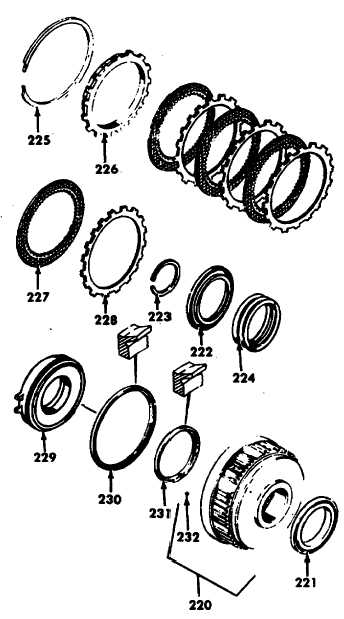|
| |
TM5-4210-229-14&P
6-15.
TRANSMISSION REPAIR (Continued).
(c) Remove the eight clutch plates (227 and
228) and piston (229). Remove sealring
(230) from the piston and sealring (231)
from fourth clutch housing (220).
(d) Remove balls (232) from fourth clutch
housing (220) only if replacement is
necessary. If necessary, clear the affected
bores of staked metal and remove the
balls (232).
(2) Assembly.
(a) If balls (232) were removed, replace them.
Place each ball in its bore. Stake each
bore at three equally spaced places. Each
bore is properly staked when the ball has
at least 0.040 inch (1.02 mm) axial
movement and when the ball is retained by
the stakes when a 301b (133 N) load is
applied against the ball.
(b) Before completing the assembly, the clutch
clearance
must
be
established.
One
method is by direct measurement and is
outlined in (c) through (g).
CAUTION
If either piston sealring (230 or 231) is
installed incorrectly, the fourth clutch
will not operate properly.
(c) Position the fourth clutch housing, rear hub
downward, on a work table. Lubricate and
install the piston sealrings (230 and 231)
into their grooves in the housing hub and
piston. Make sure the sealring lips face
toward the oil pressure side of the piston.
(d) Install the piston (229) into the fourth clutch
housing.
Alternately
install
the
four
external-tanged plates (228) and four
internal-splined plates (227). Install the
backplate (226) and retain it with the
snaprings (225).
(e) Using fourth clutch clearance gauge, check
the clearance between the backplate and
the
first
internal-splined
plate.
The
prescribed clearance for the fourch clutch
is 0.064-0.125 inch (1.625-3.175 mm).
When this clearance is achieved, the first
step of the gauge will fit between the
backplate (226) and the clutch plate; the
second step will not.
(f) If the clearance is excessive (second step
of gauge fits), replace the thinner clutch
plates with new plates. If the
6-70
|

